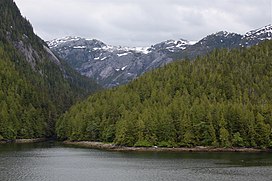Pacific Maritime Ecozone (CEC)
This article needs additional citations for verification. (December 2022) |
| Pacific Maritime | |
|---|---|
 Temperate rainforest typical of this ecozone | |
| Ecology | |
| Borders | |
| Geography | |
| Area | 207,925 km2 (80,280 sq mi) |
| Country | Canada |
| Provinces | |
| Oceans or seas | Pacific Ocean, Salish Sea |
| Climate type | Oceanic |
The Pacific Maritime Ecozone, as defined by the Commission for Environmental Cooperation (CEC), is a Canadian terrestrial ecozone, spanning a strip approximately 200 kilometres wide along the British Columbia Coast, then narrowing along the border with Alaska. It also includes all marine islands of British Columbia and a small portion of the southwestern corner of the Yukon. Fourteen ecoregions comprise the Ecozone, ranging from the Mount Logan Ecoregion in the north to the Cascade Ecoregion and Lower Mainland Ecoregion in the south.
The name of the comparable ecozones in the
Also in use is a system of
Geography
This ecozone is the most diverse in Canada, and perhaps the world.[1] Its northern inland extent is primarily alpine tundra, whereas the picturesque northern coast features numerous fjords and valleys, with massive glaciers common in the mountains. To the south, the small flatland of the Fraser Valley is located at the southern end of the Coast Mountains, noted for temperate rainforests.[2] In its marine areas are notable undersea kelp forests.
Lying on the
Ecoprovinces
This ecozone can be further subdivided into three ecoprovinces:[4]
Climate
This zone experiences the warmest and wettest climate in Canada.
Flora and fauna
The region is the only home for some species of birds, including the
The Great Bear Rainforest is located entirely within this ecozone.
Conservation
National parks
Four
- Gulf Islands National Park Reserve
- Gwaii Haanas National Park Reserve and Haida Heritage Site
- Kluane National Park and Reserve
- Pacific Rim National Park Reserve
Provincial parks
Dozens of provincial parks have been established in this ecozone. Some of the largest and most notable ones include:
- Fiordland Conservancy
- Garibaldi Provincial Park
- Juan de Fuca Provincial Park
- Kitlope Heritage Conservancy
- Strathcona Provincial Park
- Tatshenshini-Alsek Provincial Park
References
- Environment Canada. Retrieved 2008-02-04.[dead link]
- ^ a b c d "Canada's Ecozones". Space for Species. Archived from the original on 2007-12-16. Retrieved 2008-02-04.
- ^ Environment Canada. Retrieved 2008-02-04.[dead link]
- ^ Secretariat, Treasury Board of Canada. "National Ecological Framework for Canada - Open Government Portal". open.canada.ca. Archived from the original on 2020-11-13. Retrieved 2020-11-07.
- ^ Bernhardt, Torsten. "Pacific Maritime". Canada's Ecozones, Canadian Biodiversity project. McGill University, Redpath Museum. Archived from the original on 2008-02-12. Retrieved 2008-02-04.
